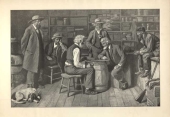The Checker Maven
The World's Most Widely Read Checkers and Draughts Publication
Bob Newell, Editor-in-Chief
Published each Saturday morning in Honolulu, Hawai`i
Contests in Progress:
McCullough's Draw

The McCullough Memorial Bridge spans Coos Bay in Oregon, and not surprisingly was called the Coos Bay Bridge when it was completed in 1936. No, it's not a draw bridge; it's what's known as a cantilever bridge. It was renamed some years later, not after checkerist R. McCullough, but instead in honor of the designer, Conde McCullough. We were unable to determine if the latter Mr. Mccullough was a checker player, but we can surely speculate that he might have been.
Today, in our Checker School lesson, we hark back to the days of checkerist McCullough, who is credited with a very practical checker draw (which has little if anything to do with a cantilever). The subject position is shown below.
BLACK
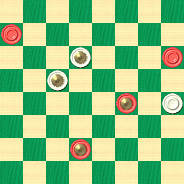
WHITE
White to Play and Draw
W:W20,K14,K10:BK26,K19,12,5.
It's another of those situations that the average checker player might write off as a loss, but in which the expert would see drawing possibilities. Can you leverage your skills and find a draw for White? When you've spanned the gap, cross over to the solution by clicking on Read More.![]()
Ryan's Bell Ringer
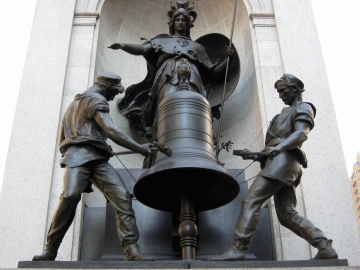
The words "bell ringer" may evoke all sorts of images, from the classic sculpture above, to the chiming of the Liberty Bell, to the exquisite sound of handbells in a church choir. In its simplest form, though, a "bell ringer" is some sort of spectacular or noteworthy positive happening. Bell ringers abound on the checkerboard, and surely one of the most knowledgeable on this topic had to have been Willie Ryan. Today, in an excerpt from his book Tricks Traps & Shots of the Checkerboard, Willie shows and tells about a "bell ringer" that is definitely worth our time. Willie tells us about it below, modestly referring to his study as "better than average"!

"Among my collection of checker papers, I came across the better than average example on the Ayrshire Lassie, played out on the next page, which is good enough to inveigle even champion players, as the trap occurs on a line of play favored by the heavyweights.
| 11-15 | 5-9 | 14-18---A, 3 |
| 24-20 | 17-13 | 32-27 |
| 8-11 | 11-16 | 9-14---B |
| 28-24 | 20-11 | 26-22 |
| 3-8 | 7-23 | 4-8---C |
| 23-19 | 27-11 | 31-26 |
| 9-14 | 8-15 | 15-19---D |
| 22-17 | 24-20 | forming |
| the diagram |
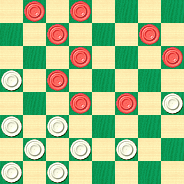
WHITE
White to Play and Win
W:W13,20,21,22,25,26,27,29,30:B1,2,6,8,10,12,14,18,19.
A---A weak move. The following play will earn a draw easily: 4-8, 25-22, 15-18, 22-15, 10-19, 29-25, 1-5, 25-22, 14-17, 21-14, 9-25, 30-21, 8-11, 26-22. Wm. F. Ryan.
B---Forced, as 10-14 loses to 26-23, while 1-5 goes down to 20-16, 12-19, 26-23, 19-26, 30-7, 2-11, 21-17, etc., with white winning. Wm. F. Ryan.
C---All that's left. 2-7 allows white to clean up with: 13-9, 6-13, 22-17,13-22, 27-23,18-27, 25-2. Again at C, if 1-5 is played, white rings the bell with this bright play: 1-5, 31-26, 2-7, 26-23, 4-8, 13-9, 6-13, 22-17, 13-22, 21-17, 14-21, 23-14, 10-17, 25-2, 8-11, 29-25, 11-15, 27-23, 5-9, 2-6, 9-14, 6-10, 15-18, 10-15*, 18-27, 20-16, 12-19, 15-31, 14-18, 31-26. Wm. F. Ryan.
D---A promising move that collapses. Black's only line of play for a draw is 2-7*---4, 26-23, 15-19*, 23-16, 12-19, 22-15, 7-11*, 30-26, 11-18, 20-16, 8-12, 16-11, 12-16. Wm. F. Ryan."
3---The computer however thinks this move is a likely draw, although computers don't distinguish the between the practical reality of an easy draw vs. a hard draw---Ed.
4---The computer prefers an alternative drawing line in which Black goes a man down for a little while: 8-11 27-24 18-23 26x19 14-18 22-17 18-23 17-14 10x17 21x14 23-27 19x10 6x15 25-22 27-32 14-10 32-28 10-7 28x19 7-3 19-23 3-8 etc. to a draw. This is a line of play that a human player would be most unlikely to select in the presence of a more straightforward option---Ed.
Can you ring the bell and solve the problem, or will you just hang around ringing the chimes? Let your mouse sound the Read More note to see Willie's solution.![]()
The Varsity Team

Tommy was, as usual for a Saturday morning, visiting with Uncle Ben on Uncle Ben's porch. Southern Florida winters are mild, and there were few Saturdays that Tommy and Uncle Ben didn't meet on the porch for Tommy's weekly checker lesson, and a glass or two of Uncle Ben's world famous lemonade--- or at least, Tommy thought it was good enough to be world famous.
Tommy was in great spirits and had just shared some fantastic news with Uncle Ben: a place had opened on the varsity checker team, and Coach Hovmiller had chosen Tommy to fill the position!

"Well, Tommy," Uncle Ben said, "you've worked long and hard for this. I know you were disappointed last year when you didn't quite make varsity, but you did very well as captain of the junior varsity, and I'm sure your coach felt you were ready for the 'big time.' Congratulations, young man!"
Tommy was all smiles--- who would not be? "Thank you, sir," he replied.
"Of course, Tommy, now you'll face some very tough competition. Middle-school varsity checkers in Florida is no piece of cake, no indeed. There are some very strong teams and some very good players, and you'll have to be at the top of your game. Now, you're already a fine player, but you will surely meet up with other boys and girls who are top notch as well. So, each week, we're going to work on problems and positions that are a little harder each time. How do you feel about that?" Of course, Uncle Ben always gave Tommy a little wink when he asked him difficult questions.
"I'm so pleased to have you helping me," Tommy said. "Not everyone is so fortunate as to get private lessons from a famous checker author! So, whatever you say, Uncle Ben, and I'll do my best!" (Ben, naturally, wasn't really Tommy's uncle, but all the young checkerists called him that, just out of courtesy and respect.)
"Then shall we begin?" asked Uncle Ben. "I have a very practical situation set up on the board here ... and of course, there's some lemonade as an aid to thinking!" So saying, he poured out two glasses and handed one to Tommy.

"Thank you Uncle Ben," Tommy said, but his voice drifted as he started to concentrate on the following position.

WHITE
White to Play and Win
W:WK14,K19,21:B12,13,K22.
Several minutes passed and Tommy had gotten through most of his glass of lemonade before he finally said, "Wow, Uncle Ben, that's a tricky one! But here's how I think White can win it ..."
Can you keep up with the newest member of the varsity team? When you've worked out the solution, click on Read More for the solution, a sample game, and numerous additional examples of the winning theme.![]()
Quigley's Rule

Astrologer Joan Quigley had her moments of fame as astrologer to nothing less than the White House during the years of the Reagan presidency in the United States. President Reagan's wife, Nancy, made the acquaintance of Ms. Quigley on a television show, and apparently was quite impressed. Ms. Quigley claimed, at least indirectly, in some respects to "rule" the White House by advising the President on key matters and protecting him from the "curse" that supposedly befell U.S. presidents elected in years whose number was evenly divisible by twenty.
We certainly can't comment in any authoritative manner on Ms. Quigley's claims, though we do recommend a certain amount of scientific skepticism. But one thing we can comment upon is the game of checkers, and in today's episode from our Checker School series, we present a position credited to G. Rule and P. Quigley, which we've chosen to call "Quigley's Rule"; perhaps not quite the same as "Quigley Rules," but we will have to make do.
BLACK
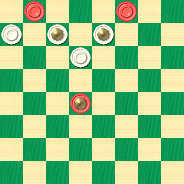
WHITE
White to Play and Win
W:W5,K6,K7,10:B1,3,K18.
We would definitely call this a "stellar" problem. White has an extra man but it's stuck in the double corner, and Black has what seems like a strong bridge position. This type of position will surely come up again and again in your own games, so align your stars and work it through. When you've predicted the right moves, click on Read More to see the solution, sample games, and explanatory notes, taken as usual from Ben Boland's Famous Positions in the Game of Checkers.![]()
Basil's Bonanza

What we seem to have in our photo above is not Basil's Bonanza but perhaps a Bonanza of Basil --- basil leaves, that is; the wonderfully-flavored herb that pairs so well with tomato; that is a staple of the Mediterranean kitchen; and which features as well in many an Asian dish.
But as usual, we need to remind our sometimes over-enthusiastic Research Department that this is, after all, a checker column; and today we're on to a different case: to wit, Basil Case, who is credited with today's theme in our ongoing series of extracts from Willie Ryan's Tricks Traps & Shots of the Checkerboard. Willie himself will tell us more.

"Basil Case, of Russellville, Alabama, has long been one of America's foremost players and analysts. A major prize winner in several national tournaments, and six times Southern States Champion, Case has milled out a considerable quantity of brilliant analysis during his checkered career. The spectacular stroke recorded here is a representative product from his robust bag of tricks.
| 11-16 | 22-17 | 10-17 |
| 24-20 | 6-10 | 21-14 |
| 16-19 | 29-25 | 15-18 |
| 23-16 | 8-11 | 32-27 |
| 12-19 | 25-22 | 1-5 |
| 22-18 | 14-18 | 28-24 |
| 9-14 | 27-23---A | 2-6 |
| 18-9 | 18-25 | 24-19 |
| 5-14 | 23-16 | 6-10 |
| 25-22 | 25-29 | See the |
| 10-15 | 17-14 | diagram |
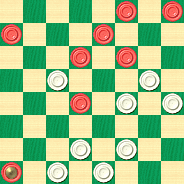
WHITE
White to Play and Draw
W:W14,16,19,20,26,27,30,31:B3,4,5,7,10,11,18,K29.
A---Introduced by Champion Case as a worthy alternative to the usual 30-25---2."
2---A few minutes of analysis on a fast computer rate 30-25 as a somewhat better move; but after nearly an hour of analysis, the computer validates Mr. Case's 27-23 as being nearly as good. Mr. Case's brain, in about five minutes of thinking time, proved every bit as good as 60 minutes on a modern computer!---Ed.
Will this be your "bonanza" problem and will you solve it forthwith, or will you be entangled in its leaves? Get on the case, and when you're ready, click on Read More to see the solution.![]()
Tonkin

Tonkin is what the French called the northern sector of Viet Nam, during the years of French occupation of that Asian nation. They derived Tonkin from the Vietnamese term Đông Kinh, which actually means "Eastern City" (not northern), and is also an old name for the Vietnamese capitol city, Ha Noi. Đông Kinh additionally is used to refer to the cities of Tokyo and Beijing. We found that the Internet contains a fair amount of incorrect information about the name Tonkin, so we hope we have set the record straight, at least to some degree.
Of course, while The Checker Maven's excellent and erudite Research Department is always anxious to impart collateral learning such as this, today's column really is about checkers, as we present another lesson in our Checker School series, a position, unsurprisingly, credited to a certain H. Tonkin. We don't know anything about Mr. Tonkin, but we're convinced that he didn't come from Ha Noi, though his origin might well have been in an eastern region of some other nation. The setting is a very practical endgame, and for a change in this series you'll find the solution is neither long nor especially difficult.
WHITE

BLACK
Black to Play and Win
B:W21,17,10:BK26,14,2.
Whether you're from the east or the north, or for that matter, somewhere else, work out the solution and then travel to Read More để xem các giải đáp cho bài (to see the solution to the problem), notes, and a sample game.![]()
A Double Boomerang

We usually think of Australia in conjunction with the boomerang, which in turn we usually think of as a device which, when thrown, will tend to return to the thrower after describing an extended aerial arc. Of course, that's the usual public over-simplification, but it is known that boomerangs were used in Australia at least ten thousand years ago. A boomerang is actually a rotating wing, and it's an example of a "heavier than air" aerial device; you might even think of it as a very distant forerunner of the airplane.
But if you want to know all about aerial boomerangs, we'll direct you elsewhere. Today's Checker Maven column, in our series taken from Willie Ryan's Tricks Traps & Shots of the Checkerboard, is about a boomerang of a different sort. Yes, indeed, checkers has its own variety of boomerang, though it doesn't have an Australian history. Willie will explain below.

"As the name implies, a boomerang shot defines a situation wherein the first player, in executing a shot, uncovers a counterstroke for the second player. Such examples are fairly common, but double boomerangs, in which the mechanical process of a straight or single boomerang occurs twice in succession, are so rare they are considered oddities. The following game illustrates one of the very few practical double boomerangs, in which 16 pieces are removed from play in a hectic series of doubles and triples.
| 9-13 | 5-9---A | 6-10 |
| 23-19 | 29-25 | 28-24 |
| 11-15 | 10-14 | 1-5---B, 1 |
| 22-18 | 27-23 | 32-28 |
| 15-22 | 8-11 | 3-8 to the |
| 25-18 | 24-20 | diagram. |
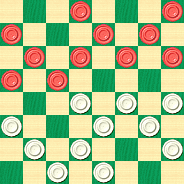
WHITE
White Plays; Black Draws
W:W31,30,28,26,25,24,23,21,20,19,18:B14,13,12,11,10,9,8,7,5,4,2.
A---Here is an old shot that Alfred Jordan used with stunning effect in his exhibition play, when handling the white pieces: 7-11, 19-15, 10-19, 24-15, 6-9, 26-23, 1-6, 29-25, 12-16, 31-26, 3-7, 28-24; at this position, 8-12 or 16-20 will produce the draw, but 16-19, 23-16, 11-20 will be smashed by 25-22, 9-14 (nothing better), 18-9, 5-14, 27-23*, 20-27, 15-10, 6-15, 23-18, 14-23, 26-3, a double exposure, and white wins.
B---This leads to a hazardous ending. Better play would be: 3-8, 25-22, 1-5, 32-28, 11-15, 18-11, 8-15, 19-16, 12-19, 23-16, 14-17, 21-14, 9-25, 30-21, 13-17, 21-14, 10-17, 26-23, etc., for a draw."
1---Here's the difference between human and computer analysis. The computer actually favors the text move, 1-5, by a slim margin; but the computer doesn't take into account how difficult it might be to thread your way through the ensuing ending, which Willie rightly characterizes as "hazardous." For a human player, trying to find the right moves over the board with the clock ticking, Willie's idea of playing 3-8 instead makes a lot of sense.
We're not sure if this is really a problem or an exercise; it's more in the nature of a study. In any case, decide how you would play this out, and then, click on Read More to circle around to Willie's high-flying line of play.![]()
One Thousand and Four
We're certain you'll be interested to know that 1004 is the Heptanacci number for n=12.

And that the "1004 Penthouse" is a popular economy lodging spot in Patagonia.

And that in the year 1004, Henry II of Germany became Holy Roman Emperor and a long war started almost at once.

In the world of checkers, though, there is problem number 1004 in Gould's Problem Book, and rather than further considering mathematical series, Argentine hostels, or medieval wars, we'd like to turn our attention instead to Ben Boland's detailed study of this difficult and controversial problem and its variants, which he in turn attributes to a William M. Courtney. As a lesson in our Checker School series, this one is long and demanding, but very much worth the effort.
Below we present six positions. It will take you some time to work through them all. When you've done so--- and no slacking, now!--- you can click on Read More to see the solutions, detailed notes and explanations, and numerous additional variations. Don't expect to finish up in an hour, or even a day; there's a lot of material here. We've quoted directly from Ben Boland's Famous Positions in the Game of Checkers.
A position by T. B. Murphy as No. 1004, Gould's Problem Book, Page 353, with solution on Page 367. A note on Page 375 says: "A very fine problem; the advantage of the Bridge and the King on 18---2 are sufficient to balance the inequality of pieces."
| For consistency, Black is at the top in all positions | ||
| T. E. Murphy No. 1 | H. Morrall No. 2 | A. McGill No. 3 |
| BLACK | BLACK | BLACK |
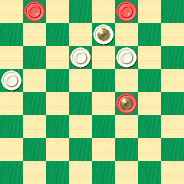 | 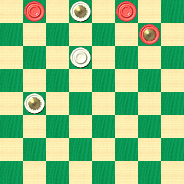 |  |
| WHITE | WHITE | WHITE |
| White Plays --- Drawn | White Plays to Win | Black Plays --- Drawn |
| W:WK7,10,11,13:B1,3,K19. | W:WK2,10,K17:B1,3,K8. | B:WK2,10,K18:B1,3,K11. |
| L. J. Vair No. 4 | J. Searight No. 5 | F. Dalumi No. 6 |
| BLACK | BLACK | BLACK |
 |  | 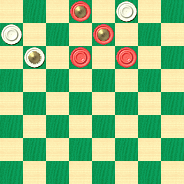 |
| WHITE | WHITE | WHITE |
| White Plays --- Drawn---1 | Black Plays --- Drawn | Black Plays to Win |
| W:WK1,K14,K32:B5,K20,28. | B:W1,3,K27:B6,10,11,14. | B:W1,3,K27:B6,10,11,14. |
1---The position was originally, and incorrectly, published as "White Plays to Win"---Ed.
2---An evident misprint; the King obviously is on 19, not 18---Ed.
![]()
Back to School, 2009

Yes, it's that time of year again, when to the general dismay of young folks everywhere, school opens again for another seemingly endless academic year. We counsel students to take courage and persevere--- it isn't really all that bad, and you will be repaid many times over in the years to come.
Our continuing Checker School lessons also offer much reward, and the effort involved is most enjoyable. This month, as we continue with studies drawn from Ben Boland's Famous Positions in the Game of Checkers, we look at three positions that seem unlike each other, but have a definite relationship that you'll understand as you study the solutions and notes.
In Mr. Wardell's study, Black has even material but a position that looks hard to defend, yet somehow must manage to draw
WHITE
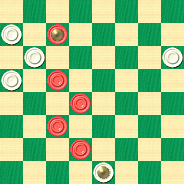
BLACK
Black to Play and Draw
B:W28,24,21,20,K2:BK27,19,15,11,7.
In the second study, by Mr. Grey, Black is a piece down and seems to need a miracle.
WHITE
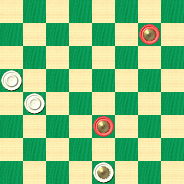
BLACK
Black to Play and Draw
B:W20,16,K2:BK25,K10
In the final study, by Mr. Hennigan, Black has even material but a rather tough-looking position, yet the draw is there.
WHITE

BLACK
Black to Play and Draw
B:W30,29,K24:B27,23,22.
Spend some time on these; after all, good lessons require effort! When you're ready, click on Read More for the solutions, sample games, and detailed study notes.![]()
Monty's King-Pinch

In the English language, the word "pinch" has a couple of different meanings. The young lady above is demonstrating the most common meaning, pinching her cheeks in a manner that we're sure she finds amusing. But today, we're going to consider another meaning of the word, namely, "to steal."
In our continuing series of excerpts from Willie Ryan's famous book, Tricks Traps & Shots of the Checkerboard, Willie talks about Monte Schleifer's clever way of stealing, or pinching, a king, via a most interesting stratagem. Willie tells us more below.

"When I was a schoolboy of 13, I learned that the City College of New York had organized a checker club for students, and were holding weekly meetings every Friday afternoon. On my initial visit to this club, I had the pleasure of meeting for the first time Monte Schleifer of Brooklyn and Jack Cox of the Bronx. Today, they rank high among the nation's leading player-analysts. As a special contribution to this book, Monty offers this attractive morsel of brilliant play, showing a clever drawing idea. For the diagram, move:
| 11-15 | 10-14---A | 4-11 |
| 24-19 | 27-24 | 24-19 |
| 15-24 | 16-20 | 6-10 |
| 28-19 | 31-27 | 29-25 |
| 8-11 | 7-11 | 12-16 |
| 22-18 | 19-15 | 19-12 |
| 11-16 | 2-1---B | 10-15. |
| 25-22 | 15-8 |
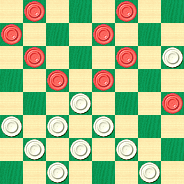
WHITE
White to Play and Draw
W:W32,30,27,26,25,23,22,21,18,12:B20,15,14,11,9,7,5,3,1.
A---The following unusual shot came up in a mail game between Joseph Viera of Nantucket, Massachusetts, and Fred Butterworth of Passaic, New Jersey: 4-8, 22-17, 8-11, 17-13, 16-20, 26-22, 11-16, 29-25, 9-14, 18-9, 5-14, 22-18, 14-17, 21-14, 10-17, 31-26, 7-10, 18-15, 3-8, 23-18, 16-23, 26-19, 17-22, 25-21, 10-14, 18-9, 1-5, 15-11 (what's going on here?), 8-31, 30-26, 5-14, 26-1; a draw. A well-played crossboard game.
B---Strongest, but 4-8, 29-25, 2-7, 24-19, 7-10, 32-28, 12-16, etc., also seal the draw."
Can you figure out how Monty pinches a king? When you've worked out your solution, click on Read More to let Willie show you how it's done.![]()
The Checker Maven is produced at editorial offices in Honolulu, Hawai`i, as a completely non-commercial public service from which no profit is obtained or sought. Original material is Copyright © 2004-2025 Avi Gobbler Publishing. Other material is the property of the respective owners. Information presented on this site is offered as-is, at no cost, and bears no express or implied warranty as to accuracy or usability. You agree that you use such information entirely at your own risk. No liabilities of any kind under any legal theory whatsoever are accepted. The Checker Maven is dedicated to the memory of Mr. Bob Newell, Sr.

